Tu-lip, Melimjo, Spinach Joint fir
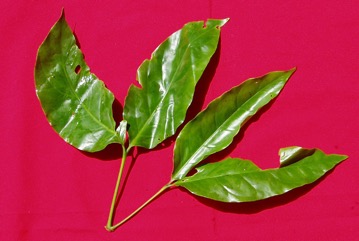
A tropical plant. It suits the lowland tropics. Trees occur in tropical rainforest from sea level to about 1200 metres altitude. It does best with rainfalls of 3000-5000 mm per year. It is best with an annual temperature of 22-30°C. It needs a temperature above 13°C. These trees grow in Malaysia, Indonesia and islands out to Fiji. They can grow on a range of soils but do best on deep well drained soils. It grows well in acid soils. It can grow in full sun but also tolerate shade. It cannot tolerate salt spray. It suits hardiness zones 10-12.
Also known as:
Ambiam, Annel, Asisang, Bago, Bagor, Bagu, Banago, Belingar, Belingo, Belinjau, Belinjo, Dae fasia, Dae malefo, Dae, Daefasia, Daemalefo, Daun dodah, Daun melinjo, Daun sabong, Eso, Gam cay bet, Gnemo, Guan zhuang mai ma teng, Hagenamu, Hanthu, Hawa, Houka, Hyinbyin, Hyingyin, Kekoso, Keigi, Khlow, Ki tangkil, Kopaiyo, Kusalu, Lenge, Leqe, Liang, Lota badam, Maninjau, Melindjo, Melinjau, Meninjau, Mhalivo, Molingu, Nyia nwasoli, Pee sae, Peesae, Pelh, Phak kariang, Phak miang, Phalap ri, Poke, Rangkil sake, Sa naroka, Sabong, Sake, Sejunteh, Shangpan,Sikau, So, Sokak, Suagafa, Suga, Sukau, Tanyin-ywe, Trangkil, Two leaf, Voe Khlaet, Wanso, Wansu, Wasu, Xian zhou mai ma teng, Yabare
Synonyms
- Gnemon domestica Rumph.
- Gnemon silvestris Rumph.
- Gnetum acutatum Miq.
- Gnetum brunonianum Griff.
- Gnetum gnemon var. domesticum MGF
- Gnetum gnemon var. laurinum Blume
- Gnetum gnemon var. lucidum Blume
- Gnetum gnemon var. majusculum Blume
- Gnetum gnemon var. ovalifolium (Poir.) Blume
- Gnetum gnemon var. stipitatum MGF
- Gnetum gnemon var. sylvestris Parl.
- Gnetum gnemon var. volubile MGF
- Gnetum griffithii Parl.
- Gnetum ovalifolium Poir.
- Gnetum silvestris Brongn.
- Gnetum vinosum Elmer
Edible Portion
- Leaves, Fruit, Flowers, Seeds, Nuts, Vegetable
Where does Tu-lip grow?
Found in: Andamans, Asia, Australia, Bougainville, Cambodia, China, East Timor, Fiji, India, Indochina, Indonesia, Malaysia, Micronesia, Myanmar, Northeastern India, Pacific, Palau, Papua New Guinea, PNG, Philippines, Samoa, SE Asia, Singapore, Solomon Islands, Thailand, Timor-Leste, Vanuatu, Vietnam, West Papua
Notes: In Slovenia presumably in a hot house. The nut contains, per 100 g edible portion, 30% moisture, 9-11% protein, 1.6-1.8% fat, 47.6-50.4% starch and 277 cal food energy. The young leaves containing, per 100 g, 71% moisture, 104 cal food energy, 7.4% protein, 2% fat, 19.4% total carbohydrates, 11.9% fibre, 44 mg calcium, 15 mg phosphorus, 1680 I.U. vitamin A and 121 mg vitamin C. There are about 28 Gnetum species. Demo
Status: It is a commercially cultivated vegetable. A particularly well liked edible green leaf occurring in almost all lowland areas of Papua New Guinea either cultivated or wild. Leaves are sold in local markets. Nuts are sold locally and internationally.
Growing Tu-lip, Melimjo, Spinach Joint fir
Cultivation: Trees are grown from seed. For using as seed for growing, a fully ripe red fruit is needed. Seeds exhibit a natural dormancy due to a hard impermeable seed coat. Breaking this seed coat can normally hasten germination. This is done by boring a hole into the seed. Propagation can be naturally by seeds distributed by birds, by planting seeds or by cuttings. A spacing of 6 m is suitable although in rows they are often put more closely. Trees appear to establish in the forest under-storey indicating some shade tolerance. Trees recover readily from pruning. Coppicing can produce a rapid flush of new leaves. Flushes of new leaves tends to occur seasonally. Trees can be topped to keep them shorter. If plants are grown by air layering they are shorter and more compact.
Edible Uses: Young leaf tips are eaten cooked. Young flowers are eaten, cooked. Young fruit are eaten, cooked. Ripe fruit are eaten raw or cooked. (Fruit should be crushed before cooking or they can explode.) Young flowers and fruit need cooking to get rid of irritating substances. The seeds are dried and flattened and then deep fried in hot oil and salt added.
Production: Trees grow by flushes of young reddish leaves. Flowers are produced throughout the year. Trees grown from seed take 5-8 years to bear fruit. Air layered trees produce fruit in 2-3 years. Leaves are harvested when fully expanded but still soft and succulent. The fruit are harvested when the skin turns red. Trees can produce 20,000 fruit per year or 6-7 kg. Yields of up to 80-100 kg per tree per year have been achieved.
Nutrition Info
per 100g edible portion| Edible Part | Energy (kcal) | Protein (g) | Iron (mg) | Vitamin A (ug) | Vitamin c (mg) | Zinc (mg) | % Water |
|---|---|---|---|---|---|---|---|
| Leaves | 90 | 5.9 | 2.7 | 3700 | 200 | - | 66 |
| Seeds | 345 | 12 | 5 | - | - | - | 13 |
| Leaves | 35 | 1.6 | 1.6 | 2220 | 66 | 0.2 | 88 |
| Fruit | 92 | 5.2 | 15.6 | - | 2.9 | 11.8 | 72.6 |
Tu-lip, Melimjo, Spinach Joint fir Photos

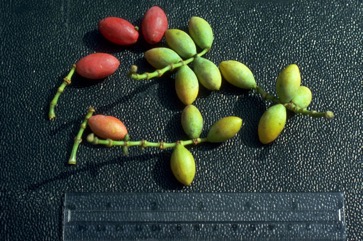
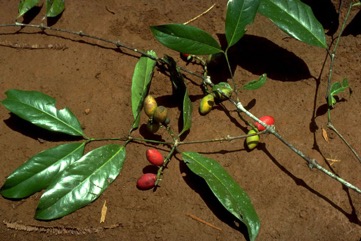
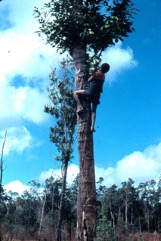
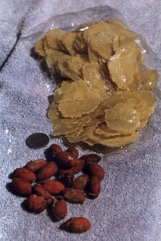
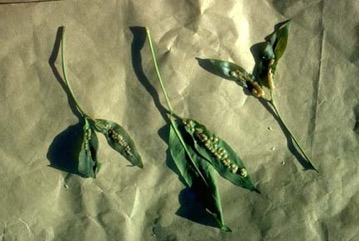
References
Tul ip references Gnetum gnemon
Ambasta, S.P. (Ed.), 2000, The Useful Plants of India. CSIR India. p 241
Arora, R. K., 2014, Diversity in Underutilized Plant Species - An Asia-Pacific Perspective. Bioversity International. p 94
Barrau, J., 1976, Subsistence Agriculture in Melanesia. Bernice P. Bishop Museu, Bulletin 219 Honolulu Hawaii. Kraus reprint. p 56
Barwick, M., 2004, Tropical and Subtropical Trees. A Worldwide Encyclopedic Guide. Thames and Hudson p 204
Biswas, S. C., et al, 2018, Diversity of wild edible minor fruits used by the ethnic communities of Tripura, India. Indian Journal of Traditional Knowledge. Vol 17(2), April 2018, pp 282-289
Blume, 1848, Rumphia 4 p3 t176
Borrell, O.W., 1989, An Annotated Checklist of the Flora of Kairiru Island, New Guinea. Marcellin College, Victoria Australia. p 11, 153
Bremness, L., 1994, Herbs. Collins Eyewitness Handbooks. Harper Collins. p 59
Brown, W.H., 1920, Wild Food Plants of the Philippines. Dept. Ag & Natural Resources Bureau of Forestry. Bulletin No 21 p
Brown, W.H., 1920, Wild Food Plants of the Philippines. Bureau of Forestry Bulletin No. 21 Manila. p 22
Burkill, I.H., 1966, A Dictionary of the Economic Products of the Malay Peninsula. Ministry of Agriculture and Cooperatives, Kuala Lumpur, Malaysia. Vol 1 (A-H) p 1109
Cabalion, P. and Morat, P., 1983, Introduction le vegetation, la flore et aux noms vernaculaires de l'ile de Pentcoste (Vanuatu), In: Journal d'agriculture traditionnelle et de botanique appliquee JATBA Vol. 30, 3-4
Chai, P. P. K. (Ed), et al, 2000, A checklist of Flora, Fauna, Food and Medicinal Plants. Lanjak Entimau Wildlife Sanctuary, Sarawak. Forestry Malaysia & ITTO. p 159, 168
Chin, H.F., & Yong, H.S., 1996, Malaysian Fruits in Colour. Tropical press, Kuala Lumpur p 65
Clarke, W.C. & Thaman, R.R., 1993, Agroforestry in the Pacific Islands: Systems for sustainability. United Nations University Press. New York. p 240
Corner, 1940, Wayside Trees of Malaya. p726 pl 1227-228
Coronel, R.E., 1982, Fruit Collections in the Philippines. IBPGR Newsletter p 7
Cowie, I, 2006, A Survey of Flora and vegetation of the proposed Jaco-Tutuala-Lore National Park. Timor-Lests (East Timor) www.territorystories.nt/gov.au p 48
Crevost, 1920, Bull. Econ., Indochine 22:428
Cundall, P., (ed.), 2004, Gardening Australia: flora: the gardener's bible. ABC Books. p 645
De Clerq 1909, Niew Plantk. Woordenb. p249 no. 1671
Den Berger, 1949, Determinatietabel Houtsoorten van Malesie Wageningen 35
Dobriyal, M. J. R. & Dobriyal, R., 2014, Non Wood Forest Produce an Option for Ethnic Food and Nutritional Security in India. Int. J. of Usuf. Mngt. 15(1):17-37
Duke, J.A., 1989, CRC Handbook of Nuts. CRC Press Florida p 166, 167
Etherington, K., & Imwold, D., (Eds), 2001, Botanica's Trees & Shrubs. The illustrated A-Z of over 8500 trees and shrubs. Random House, Australia. p 349
Ethnobotany of Karbis. Chapter 4 in p 104
Evans, B. R, 1999, Edible nut Trees in Solomon Islands. A variety collection of Canarium, Terminalia and Barringtonia. ACIAR Technical Report No. 44 96pp
Facciola, S., 1998, Cornucopia 2: a Source Book of Edible Plants. Kampong Publications, p 119
Fagerlind, 1946, Ark, For. Bot. 33A no 8
Filet, 1888, Plantk Woordenb. 2nd ed p 38 No. 820
Flora Malesiana Vol 13 p 341
Food Composition Tables for use in East Asia FAO http://www.fao.org/infoods/directory No. 320
French, B.R., 1986, Food Plants of Papua New Guinea, A Compendium. Asia Pacific Science Foundation p 57
French, B.R., 2010, Food Plants of Solomon Islands. A Compendium. Food Plants International Inc. p
Furusawa, T., et al, 2014, Interaction between forest biodiversity and people's used of forest resources in Roviana, Solomon Islands: implications for biocultural conservation under socioeconomic changes. Journal of Ethnobiology and Ethnomedicine, 10:10
Gillaumin, R., 1954, Les Plantes utiles des Nouvelles-Hebrides (fin et complement) In: Journal d'agriculture tropicale et de botanique appliquee Vol. 1, No. 10-12 pp 453-460
GTZ 1996, A Guide to some Indigenous Fijian Trees. GTZ Suva. p 175
Hale, P.R. & Williams, B.D., 1977, Liklik Buk p22 Melanesian Council of Churches.
Hartley, T.C., 1973, A Survey of New Guinea Plants for Alkaloids. Lloydia 36(3):232.
Havel, J.J., 1975, Forest Botany, Volume 3 Part 2 Botanical taxonomy. Papua New Guinea Department of Forests, p 28
Hedrick, U.P., 1919, (Ed.), Sturtevant's edible plants of the world. p 331
Henderson, C.P. and I.R.Hancock, 1988, A Guide to the Useful Plants of the Solomon Islands. Res. Dept. Min of Ag. & Lands. Honiara, Solomon Islands. p 120 (As Gnetum gnemon var. gnemon)
Heyne, K., 1927, Nutt. Pl. p121-125
Hunter, 1909, Jourmn Roy As. Soc. Straits branch 53 p116
Hutton, W., 1997, Tropical Herbs and Spices of Indonesia. Periplus. p 40
Jacquat, C., 1990, Plants from the Markets of Thailand. D.K. Book House p 34
Jansen, A. A. J., et al, (Eds), 1990, Food and Nutrition in Fiji. Volume One. p 52
Japanese International Research Centre for Agricultural Science www.jircas.affrc.go.jp/project/value_addition/Vegetables
Johns, R.J., 1976, Common Forest Trees of Papua New Guinea. Part 1 Gymnospermae, Forestry College Bulolo, PNG p 26
Kar, A., & Borthakur, S. K., 2007, Wild vegetables sold in local markets of Karbi Anglong, Assam. Indian Journal of Traditional Knowledge. 6(1) January 2007, pp 169-172
Kar, A., et al, 2013, Wild Edible Plant Resources used by the Mizos of Mizoram, India. Kathmandu University Journal of Science, Engineering and Technology. Vol. 9, No. 1, July, 2013, 106-126
Kays, S. J., and Dias, J. C. S., 1995, Common Names of Commercially Cultivated Vegetables of the World in 15 languages. Economic Botany, Vol. 49, No. 2, pp. 115-152
Koorders en Valeton, 1903, Booms. Java 9, p 949
Koorers, 1911, Exkflora von Java 1 p 68
Koorders, 1913, Atlas Exkflora Java part 1p2 fig 4
La Riviere, 1916, Ann. Jard. Bot. Buitenzorg 30:23
Lacuna-Richman, C., 2006, The use of non-wood forest products by migrants in a new settlement: experiences of a Visayan community in Palawan, Philippines. Journal of Ethnobiology and Ethnomedicine. 2:36 (As Gnetum gnemon var. gnemon)
Lembogi Biologi Nasional, 1980, Sayur-sayuran. Balai Pustaka, Jakarta. p 82
Lugod, G.C. and de Padua L.S., 1979, Wild Food Plants in the Philippines. Vol. 1. Univ. of Philippines Los Banos. p 37
Lungphi, P., Wangpan, T. & Tangjang, S., 2018, Wild edible plants and their additional uses by the Tangsa community living in the Changlang district of Arunachal Pradesh, India. Pleione 12(2): 151 - 164. 2018.
Mac Duffie, 1921, Bt Gaz. 71, 438
Macmillan, H.F. (Revised Barlow, H.S., et al) 1991, Tropical Planting and Gardening. Sixth edition. Malayan Nature Society. Kuala Lumpur. p 301
Maghirang, R. G., et al, 2018. Ethnobotanical Studies of Some Plants Commonly Used as Vegetables in Selected Provinces of the Philippines. Journal of Nature Studies. 17(2), 30-43.
Mant. pl. 1:125. 1767
Maranon, J., 1935, Nutritive Mineral Value of Philippines food plants. Philip. Journ Sci. 58:317-358.
Margraf, F., 1930, Bull., Jardn Bot. Btzg 111,10:407 map 1-8, t 1-14
Margraf, F., 1932, Pflanzenareale 3 map 31-40.
Margraf, F., 1951, Gnetaceae in Flora Malesiana 1:339-341
Martin, F.W. & Ruberte, R.M., 1979, Edible Leaves of the Tropics. Antillian College Press, Mayaguez, Puerto Rico. p 91, 193
Massal, E. and Barrau, J., 1973, Food Plants of the South Sea Islands. SPC Technical Paper No 94. Nounea, New Caledonia. p 33
McClatchey, W. C., 2012, Wild food plants of Remote Oceania. Acta Societatis Botanicorum Poloniae 81(4) 371-380
Medhi, P. & Borthakur, S. K., 2012, Phytoresources from North Cachur Hills of Assam -3: Edible plants sold at Hflong market. Indian Journal or Natural Products and Resources. 3(1) pp 84-109
Medhi, P. & Borthakur, S. K., 2013, Wild edible plants sold by the Zeme Nagas at the makeshift market of Mahur, Dima Hasao district of Assam. Pleione 7(1): 84 - 93. 2013
Medhi, P., Sarma, A and Borthakur, S. K., 2014, Wild edible plants from the Dima Hasao district of Assam, India. Pleione 8(1): 133-148
Menninger, E.A., 1977, Edible Nuts of the World. Horticultural Books. Florida p 159
Miquel, 1860, Fl. Ind. Bat. Suppl. 251, 588
Monsalud, M.R., Tongacan, A.L., Lopez, F.R., & Lagrimas, M.Q., 1966, Edible Wild Plants in Philippine Forests. Philippine Journal of Science. p 471 (As Gnetum gnemon var. gnemon)
Mozhui, R., et al, 2011, Wild edible fruits used by the tribals of Dimapur district of Nagaland, India. Pleione 5(1): 56 - 64.
Nombo, P. & Leach, J. 2010, Reite Plants: An Ethnobotanical Study in Tok Pisin and English. ANU press. p 117
Ochse, J.J., 1925, Tropische Groenten p72 with fig.
Ochse, J.J., 1927, Ind. Vruchten p85.
Ochse, J.J. et al, 1931, Vegetables of the Dutch East Indies. Asher reprint. p 296
Oomen, H.A.P.C., & Grubben, G.J.H., 1978, Tropical Leaf Vegetables in Human Nutrition, Communication 69, Department of Agricultural research, RTI Amsterdam, p 20, 36, 97,
Owen, S., 1993, Indonesian Food and Cookery, INDIRA reprints. p 73
Pawera, L., et al, 2020, Wild Food Plants and Trends in Their Use: From Knowledge and Perceptions to Drivers of Change in West Sumatra, Indonesia, Foods. 2020, 9, 1240
Peekel, P.G., 1984, (Translation E.E.Henty), Flora of the Bismarck Archipelago for Naturalists, Division of Botany, Lae, PNG. p 37, 36
Pham-Hoang Ho, 1999, An Illustrated Flora of Vietnam. Nha Xuat Ban Tre. p 215
Priyadi, H., et al, Five hundred plant species in Gunung Halimun Salak National Park West Java. A checklist including Sundanese names, distribution and use. CIFOR, FFPRI, SLU p 161
PROSEA (Plant Resources of South East Asia) handbook, Volume 2, 1991, Edible fruits and nut. p 182
Reis, S. V. and Lipp, F. L., 1982, New Plant Sources for Drugs and Foods from the New York Botanical Garden herbarium. Harvard. p 7
Ridley, , 1911, Jourmn. Roy. As. Soc. Straits Branch 60:60
Ridley, , , Dispersal p240, 352.
Ridley, 1925, Flora of the Malay Peninsula Vol 5 p273.
Rumphius, 1741, Herb. Amb. 1:181 t71, 72
, 1977, Sayur Sayuran p82 Lambaga Biologi Nasional - LIPI
Salvi, J. et al, 2016, A review: Underutilized wild edible plants as a potential source of alternative nutrition. International Journal of Botany Studies. Volume 1; Issue 4; May 2016; Page No. 32-36
Saw, L.G., LaFrankie, J. V. Kochummen, K. M., Yap S. K., 1991, Fruit Trees in a Malaysian Rain Forest. Economic Botany, Vol. 45, No. 1, pp. 120-136
Slik, F., www.asianplant.net
Solomon, C., 2001, Encyclopedia of Asian Food. New Holland. p 174, 233
Smith, A.C., 1979, Flora Vitiensis Nova, Lawaii, Kuai, Hawaii, Volume 1 p 120
Steenis, ed. 1948-. Flora malesiana.
Sukarya, D. G., (Ed.) 2013, 3,500 Plant Species of the Botanic Gardens of Indonesia. LIPI p 309
Sukenti, K., et al, 2016, Ethnobotanical study on local cuisine of the Sasak tribe in Lombok Island, Indonesia. Journal of Ethnic Foods. 3 (2016) 189-200 p 198
Tankard, G., 1990, Tropical fruit. An Australian Guide to Growing and using exotic fruit. Viking p 130 (As Gnetum gnemon var. gnemon)
Terangpi, R., et al, 2013, Utilization of less known plants, Gnetum gnemon L. and Rhynchotechum ellipticum (Dietr.)A. DC. among the Karbis, Northeast India. Journal of Scientific and Innovative Research 2013; 2 (5): 943-949
Teron, R. & Borthakur, S. K., 2016, Edible Medicines: An Exploration of Medicinal Plants in Dietary Practices of Karbi Tribal Population of Assam, Northeast India. In Mondal, N. & Sen, J.(Ed.) Nutrition and Health among tribal populations of India. p 152
Terra, G. J. A., 1973, Tropical Vegetables. Communication 54e Royal Tropical Institute, Amsterdam, p 48, 49
Terrell et al. 1986. Agric. Handb. no. 505.
Thompson, 1918, Bot. Gaz. 65:83.
Tindall, H.D., & Williams, J.T., 1977, Tropical Vegetables and their Genetic Resources, International Board for Plant Genetic Resources, Rome, p 107
Ting, H., Tan, S. & Nastassia, J. A., 2017, Consumption intention toward ethnic food: determinants of Dayak food choice by Malaysians. Journal of Ethnic Foods (2017) 1-7
Trimanto, & Hapsari L., 2016, Botanical survey in thirteen montane forests of Bawean Island Nature Reserve, East Java Indonesia: Conservation status, bioprospecting and potential tourism. Biodiversitas 17: 832-846.
Van Sam, H. et al, 2008, Uses and Conservation of Plant Species in a National Park. A case study of Ben En, Vietnam. Economic Botany 62:574-593
van Wyk, B., 2005, Food Plants of the World. An illustrated guide. Timber press. p 203
Wahyudi, 2017, Non-timber Forest Product (NTFP) Commodities Harvested and Marketed by Local People at the Local Markets in Manokwari - West Papua. Indonesian Journal of Forestry Research Vol. 4, No. 1, 27-35
Walter, A & Sam, C., 1995, Indigenous Nut Trees in Vanuatu: Ethnobotany and Variability. In South Pacific Indigenous Nuts. ACIAR Proceedings No 69. Canberra. p 57
Walter, A. & Sam C., 2002, Fruits of Oceania. ACIAR Monograph No. 85. Canberra. p 180
Wester, 1917, Philipp. Agric Rev. 10:9
Wester, P.J., 1925, The Food Plants of the Philippines. Bureau of Agric. Bull., 39:213
Wickens, G.E., 1995, Edible Nuts. FAO Non-wood forest products. FAO, Rome. p175
www.worldagroforestrycentre.org/sea/products/afdbases/af/asp/SpeciesInfo.asp?SpID=1751
www.worldagroforestrycentre.org/treedb/
Yaacob, O. & S. Subhadrabandhu, Oxford Univ. Press. 1995. The production of economic fruits in South-East Asia.
Yen, D.E., 1974, Arboriculture in the Subsistence of Santa Cruz, Solomon Islands. Econ. Bot. 28:252-254
World Checklist of Useful Plant Species 2020. Royal Botanic Gardens, Kew
Zawiah, N. & Othaman, H., 2012, 99 Spesies Buah di FRIM. Institut Penyelidikan Perhutanan Malaysia. p 136